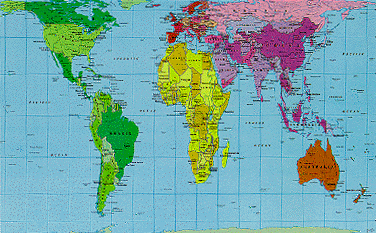
Actually, for white students, this may be a good thing. When white genocide is discussed or purported by some, they need to realize there is truth to it. Even the geographical regions that serve primarily as homelands for white people are smaller in comparison to others’ lands. Considering the non-white immigration into these lands one can see a recipe for genocide.
Joanna Walters, Guardian
When Boston public schools introduced a new standard map of the world this week, some young students’ felt their jaws drop. In an instant, their view of the world had changed.
The USA was small. Europe too had suddenly shrunk. Africa and South America appeared narrower but also much larger than usual. And what had happened to Alaska?
In an age of “fake news” and “alternative facts”, city authorities are confident their new map offers something closer to the geographical truth than that of traditional school maps, and hope it can serve an example to schools across the nation and even the world.
For almost 500 years, the Mercator projection has been the norm for maps of the world, ubiquitous in atlases, pinned on peeling school walls.
Gerardus Mercator, a renowned Flemish cartographer, devised his map in 1569, principally to aid navigation along colonial trade routes by drawing straight lines across the oceans. An exaggeration of the whole northern hemisphere, his depiction made North America and Europe bigger than South America and Africa. He also placed western Europe in the middle of his map.
Mercator’s distortions affect continents as well as nations. For example, South America is made to look about the same size as Europe, when in fact it is almost twice as large, and Greenland looks roughly the size of Africa when it is actually about 14 times smaller. Alaska looks bigger than Mexico and Germany is in the middle of the picture, not to the north—because Mercator moved the equator.
Three days ago, Boston’s public schools began phasing in the lesser-known Peters projection, which cuts the US, Britain and the rest of Europe down to size. Teachers put contrasting maps of the world side by side and let the students study them.
Natacha Scott, director of history and social studies at Boston public schools, said it was “interesting to watch the students saying ‘Wow’ and ‘No, really? Look at Africa, it’s bigger’”.
“Some of their reactions were quite funny,” she added, “but it was also amazingly interesting to see them questioning what they thought they knew.”
Individual schools in the US have used the Peters maps, Scott said, adding: “We believe we are the first public school district in the US to do this.”
‘It’s a paradigm shift’
The German historian Arno Peters published his projection in 1974. It matches work by a Scottish 19th-century mapmaker, James Gall, and is also known as the Gall-Peters projection. It is an “equal-area” map, distorting the shape of countries as a two-dimensional visualization of a three-dimensional globe but accurately scaling surface areas.
The result goes a long way to rewriting the historical and sociopolitical message of the Mercator map, which exaggerates the size of imperialist powers.
“This is the start of a three-year effort to decolonize the curriculum in our public schools,” said Colin Rose, assistant superintendent of opportunity and achievement gaps for Boston public schools.
The district has 125 schools and 57,000 students, 86% of whom are non-white, with the largest groups being Latino and black. After changing the maps, Rose said, educators plan to look at other subjects and shift away from presenting white history as the dominant perspective.
To begin with, the Peters maps are being introduced to one grade level in elementary school, one in middle school and one in high school. They will then be phased into all grades. Mercator projection maps will not be removed but all new maps purchased will be the Peters projection, Rose said. The decision, he said, was made internally and not put to public consultation.
The respective merits of the Mercator and the Peters maps have long been debated. A spirited discussion about their implications even featured on an episode of the West Wing, in which characters argued for the Peters map to be used in US public schools and told the administration the Mercator projection had “fostered European imperialist attitudes for centuries”, creating an “ethical bias” for “western civilization” against the developing world.
“Maybe we can be an example for other school districts,” said Rose. “It’s a paradigm shift. It’s important that students trust the material they are given in school but also question it.
“The Mercator projection is a symbolic representation that put Europe at the center of the world. And when you continue to show images of the places where people’s heritage is rooted that is not accurate, that has an effect on students.”
Curriculum chiefs consulted map experts at the Boston public library and were directed to ODT, a company in Amherst, Massachusetts, that is the exclusive North American publisher of Peters projection maps.
ODT founder Bob Abramms said: “The Peters projection has created a lot of controversy over the years because it distorts shapes, but it’s enormously visually important in terms of the scale and position of the terrain on the Earth, showing correct size and proportion of the continents.”
Jane Elliott is an Iowa-based lecturer in race relations who became famous for a landmark antiracism exercise, immediately after the assassination of Martin Luther King Jr in 1968, which involved instructing white schoolchildren to discriminate against one another based on eye color. On Saturday, she said she was delighted to hear of Boston’s move.
“The Mercator projection showed the spread and power of Christianity and is standard,” she said. “But it is not the real world at all. What the Boston public schools are doing is extremely important and should be adopted across the whole of the US and beyond.”
Elliott, who is still teaching at 83, said she was booked to give lectures in Michigan, Iowa, Missouri and Texas this week, and would be hailing Boston’s move.
“This is going to change how kids see the world much for the better,” she said.


